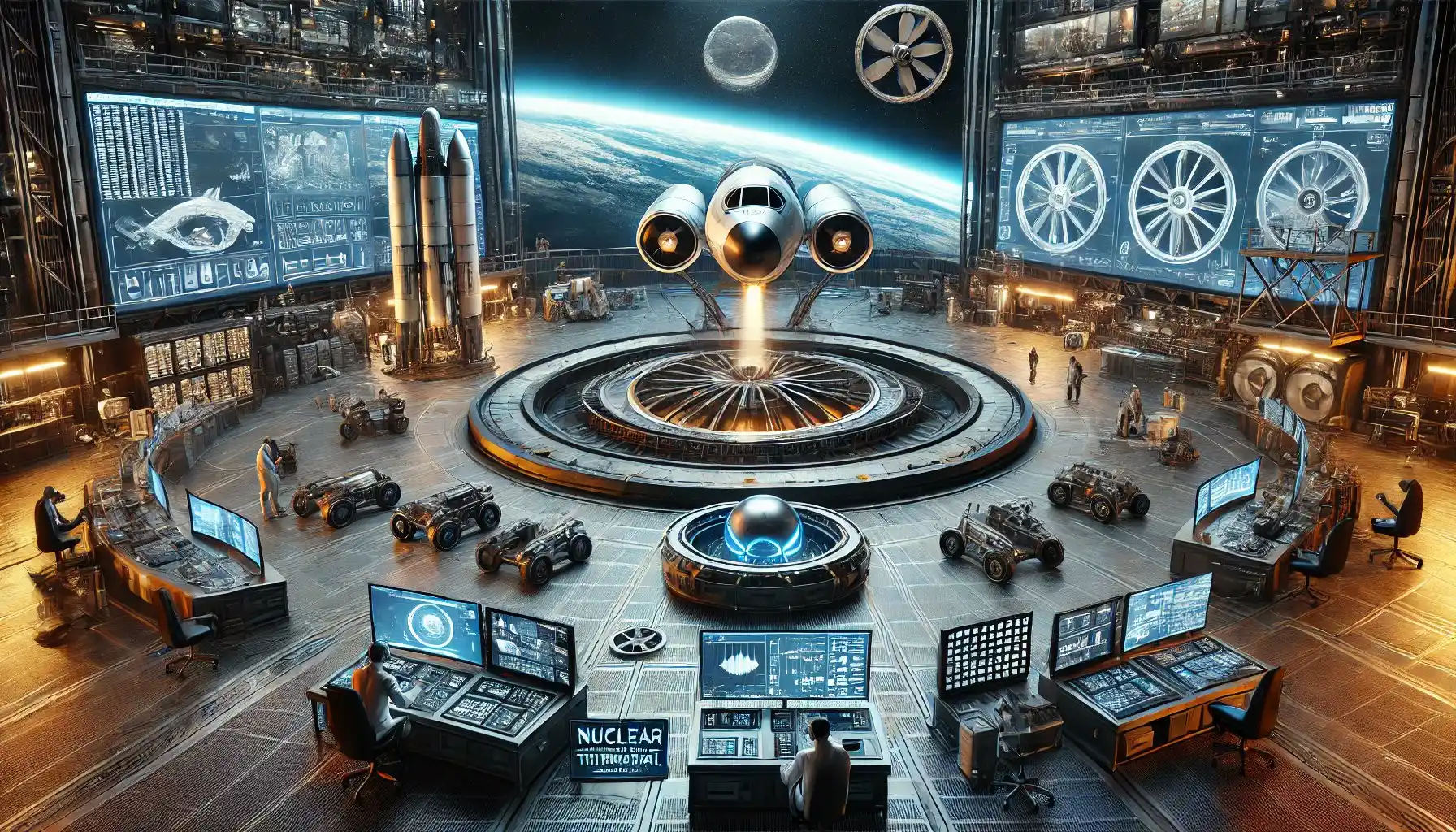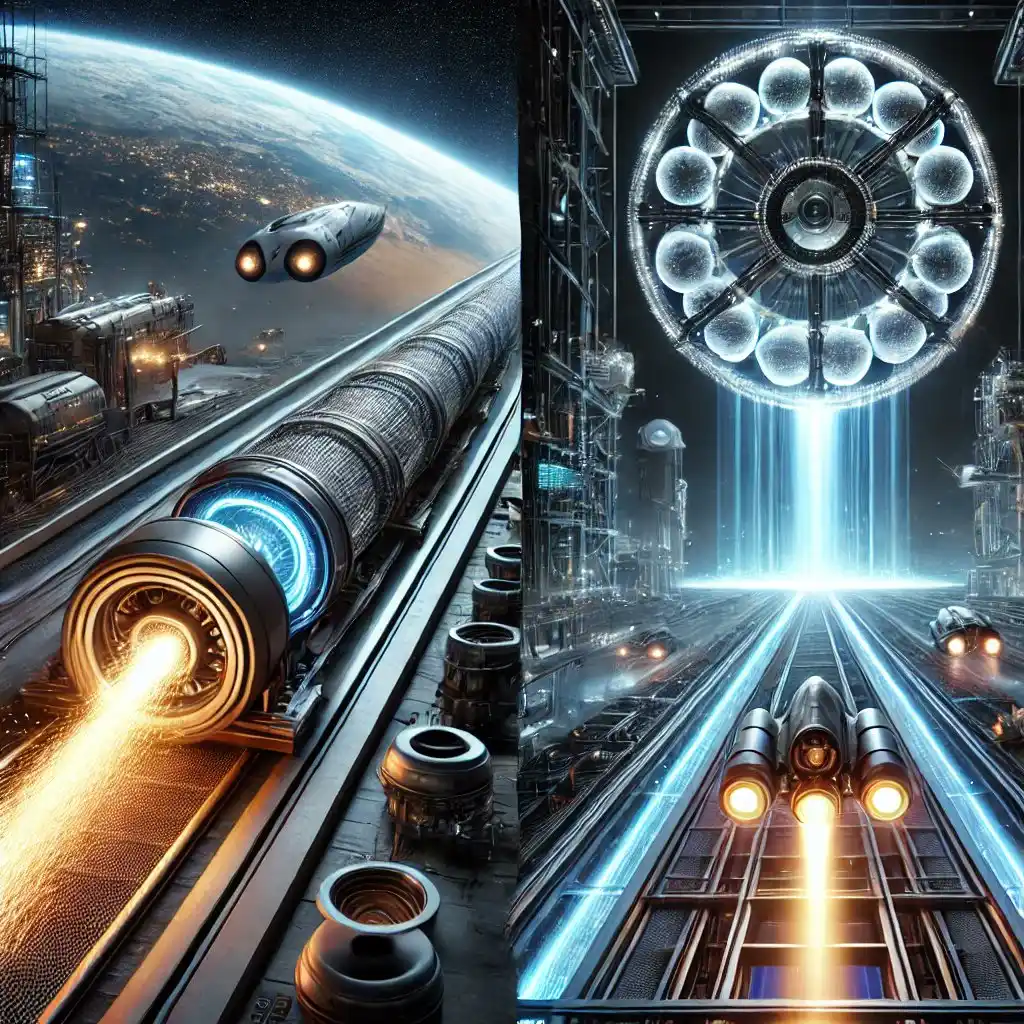Breaking the Gravity Barrier for Sustainable, Continuous Space Logistics
Abstract
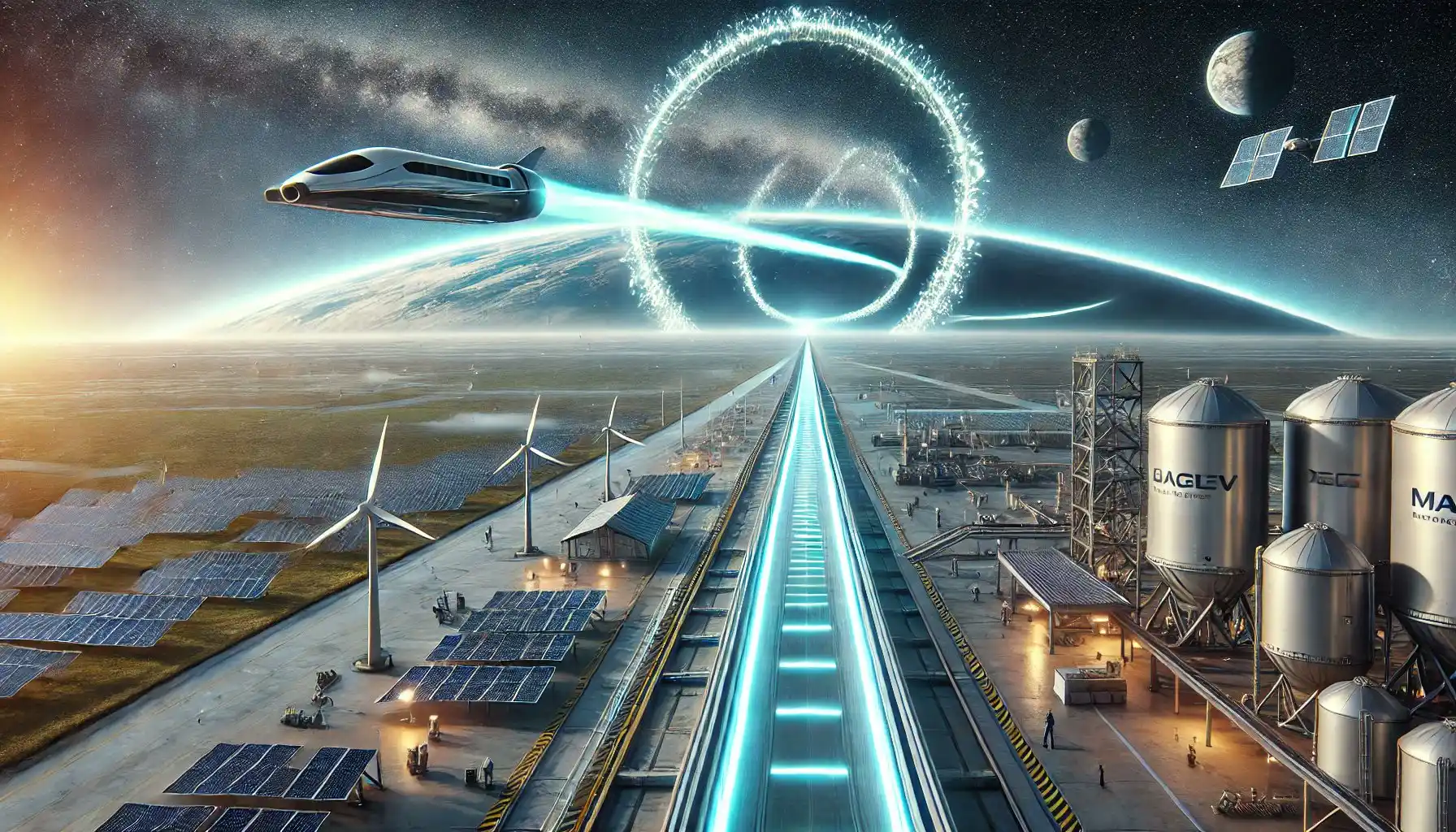
I. Vision: The Limits of Now and the Promise of Tomorrow
The Gravity Trap: Overcoming Our Terrestrial Shackles
The Legacy of Exploration and the Dawn of a New Epoch
A Call for a Paradigm Shift
The Promise of Tomorrow: Our Interplanetary Destiny
-
Economically Transform space commerce, unleashing new industries such as asteroid mining, in-space manufacturing, and space tourism.
-
Accelerate Scientific Discovery by enabling frequent deployments of sophisticated telescopes and deep-space laboratories.
-
Inspire Cultural Renaissance, rekindling the human spirit and expanding the boundaries of what is possible.
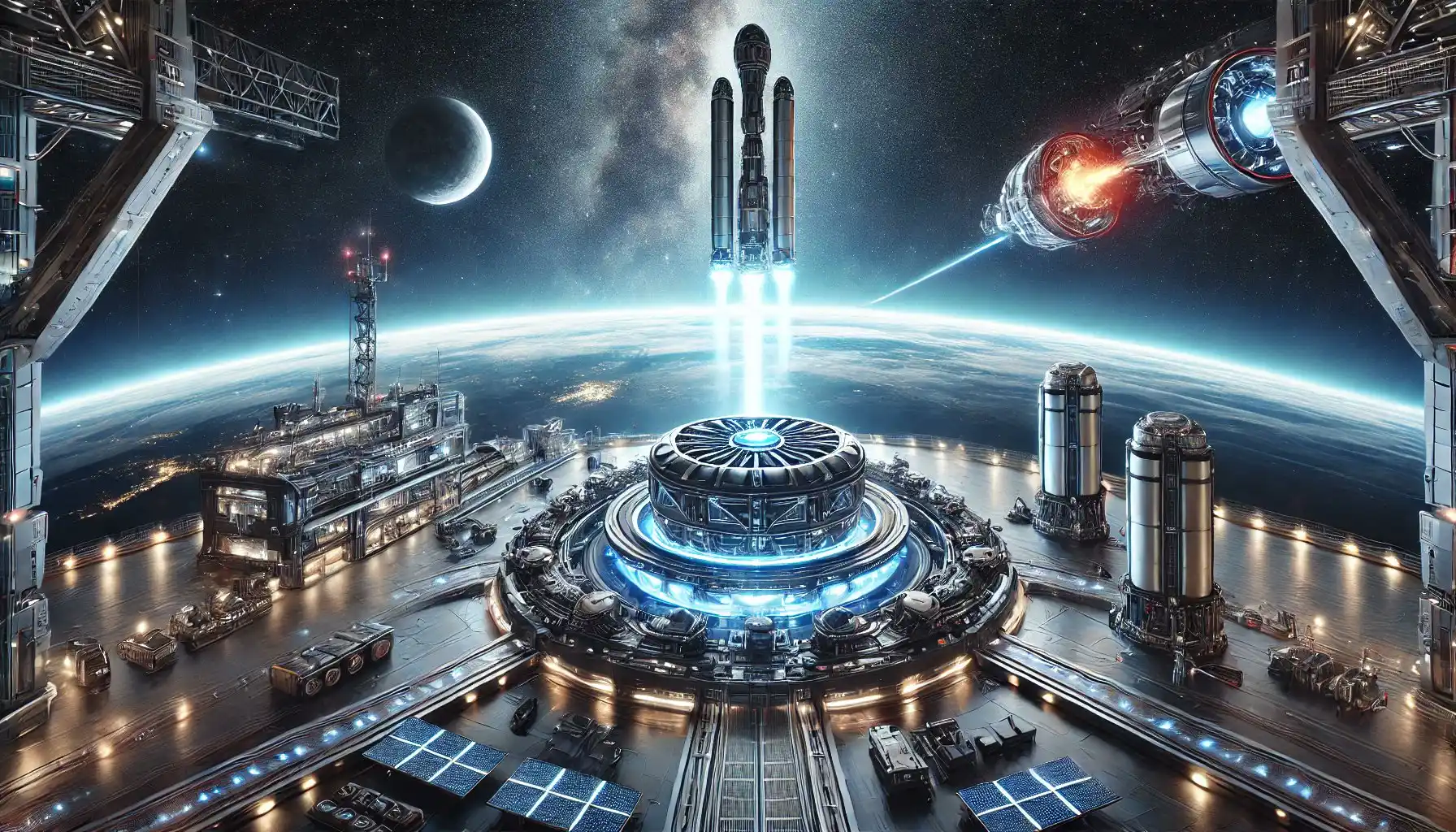
II. The Hybrid Solution: Breaking the Chains of Gravity
A. Stage 1: The Maglev Catapult – Earth’s Gateway to the Stars
1. The Concept: Electromagnetic Launch as Revolution
2. Engineering Marvels: Technology Behind the Launch
-
Superconducting Magnet Arrays and Cryogenics: By employing high-temperature superconductors like YBCO, our magnets achieve nearly zero electrical resistance at cryogenic temperatures. Innovative configurations (e.g., Halbach arrays) maximize field concentration and propulsion efficiency (Poole et al., 2017).
-
Multi-Stage Acceleration Strategy: The system is divided into two phases: Ground-Level Boost: Payloads are accelerated to 2 – 3 km/s along a composite track using magnetic levitation. A spin-launch mechanism may impart additional momentum. High-Altitude Vacuum-Assisted Stage: A subsequent phase (in a high-altitude environment or vacuum tunnel) boosts speeds to 5 – 6 km/s, reducing aerodynamic drag and thermal stress.
-
Precision Track Engineering: Constructed from graphene-enhanced composites and carbon nanotube reinforcements, the track maintains sub-millimeter alignment over extensive distances. Embedded sensors and dynamic adjustment systems, along with vacuum sections, ensure an optimal trajectory.
-
High-Power Energy Delivery: State-of-the-art pulsed power electronics and Superconducting Magnetic Energy Storage (SMES) systems deliver precise energy bursts. Sourced from renewable energy and advanced nuclear reactors, this system minimizes the carbon footprint while ensuring efficiency.
3. The Advantages: Efficiency, Sustainability, and Scalability
B. Stage 2: The Space Ferry – Enabling Seamless In-Space Transit
1. Transitioning from Launch to Deep-Space Operation
2. Advanced Nuclear Thermal Propulsion (NTP)
-
High Thrust Efficiency: This system substantially reduces fuel requirements and accelerates transit times.
-
Safety and Redundancy: With built-in redundancies and advanced radiation shielding, the reactor activates only after safe separation from Earth’s atmosphere, ensuring robust safety and reliability.
3. Autonomous Operations and Modular Design
-
Autonomous Rendezvous and Robotic Capture: A sophisticated network of lidar, radar, and optical sensors, coupled with AI algorithms, directs high-precision robotic arms to execute flawless docking maneuvers.
-
Modularity and Reusability: The reconfigurable cargo bay facilitates rapid turnaround, in-orbit refueling, and maintenance, ensuring the Space Ferry remains a reliable link in the continuous logistics chain.
C. Synergistic Integration: A Unified Architecture for Continuous Space Logistics
-
Maximizes Efficiency: Each stage operates in its optimal domain.
-
Ensures Continuous Flow: A high-frequency launch cadence paired with rapid orbital transfers provides a steady stream of payloads.
-
Accumulates Economic and Environmental Benefits: Reduced propellant consumption and a focus on reusability generate significant cost savings and lower environmental impact.
D. A Vision Realized
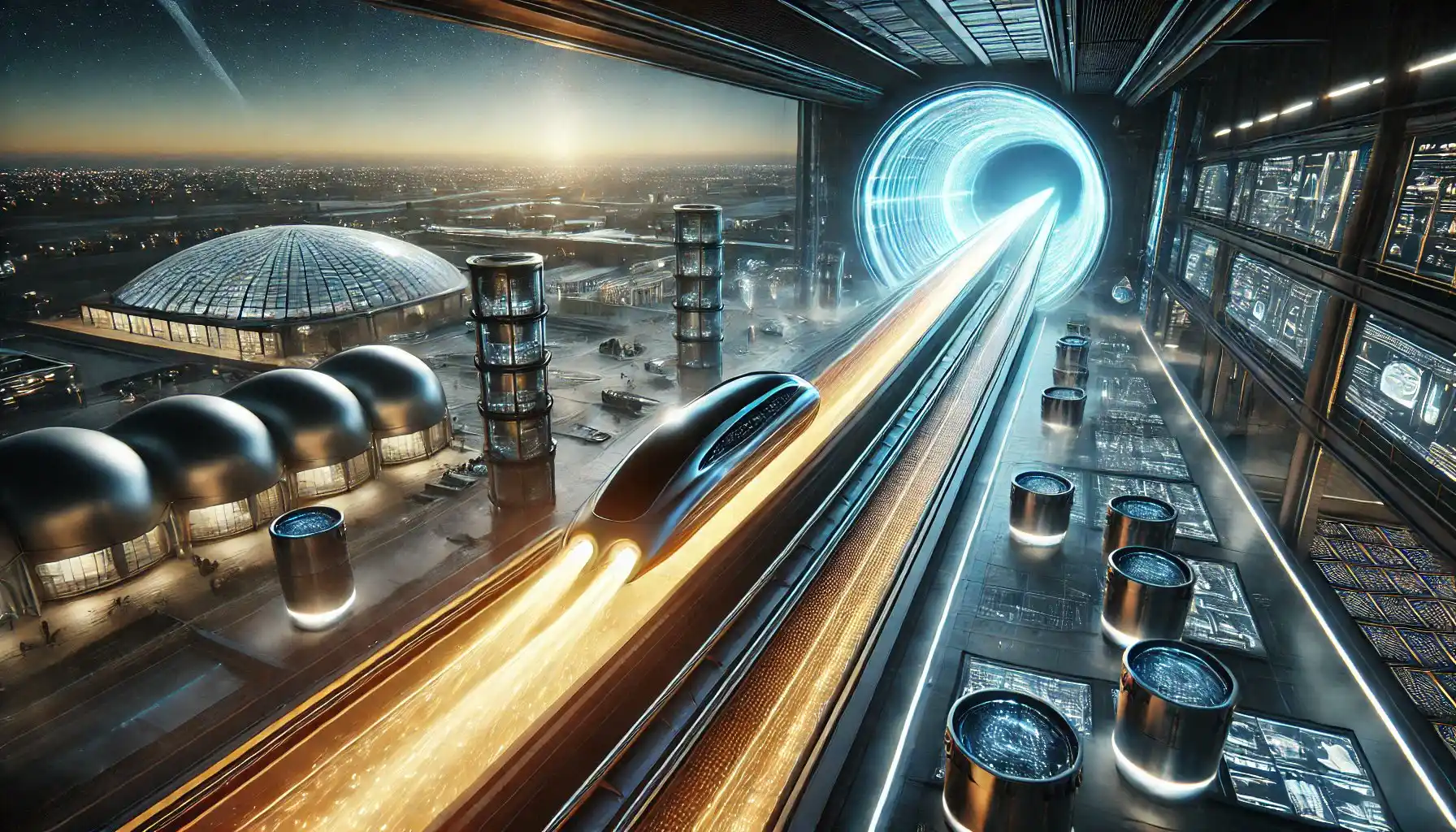
III. Engineering Marvels: The Technologies That Define Tomorrow
A. Maglev Mastery: Harnessing Electromagnetism to Launch the Future
1. Superconducting Magnet Arrays and Cryogenic Advancements
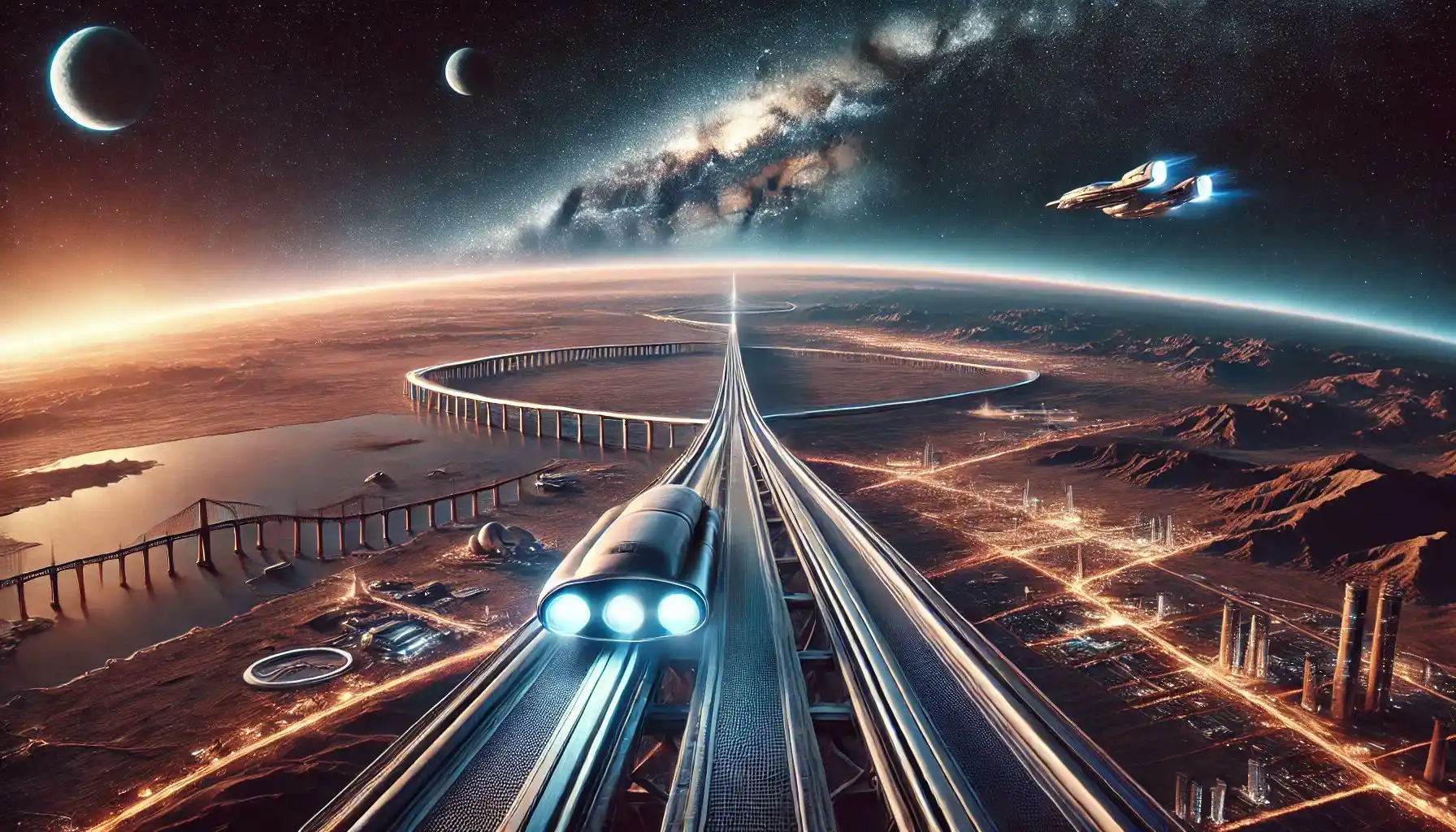
2. Multi-Stage Acceleration and Dynamic Control
-
Initial Boost: Magnetic levitation on an ultra-smooth composite track accelerates payload shells to 2 – 3 km/s.
-
High-Altitude/Vacuum Stage: Operating in a reduced-pressure environment minimizes drag and thermal stress, boosting velocities to 5 –6 km/s. These stages are governed by dynamic control systems that adjust magnetic field strengths in real time, ensuring precise acceleration profiles.

3. Advanced Track Engineering and Energy Infrastructure
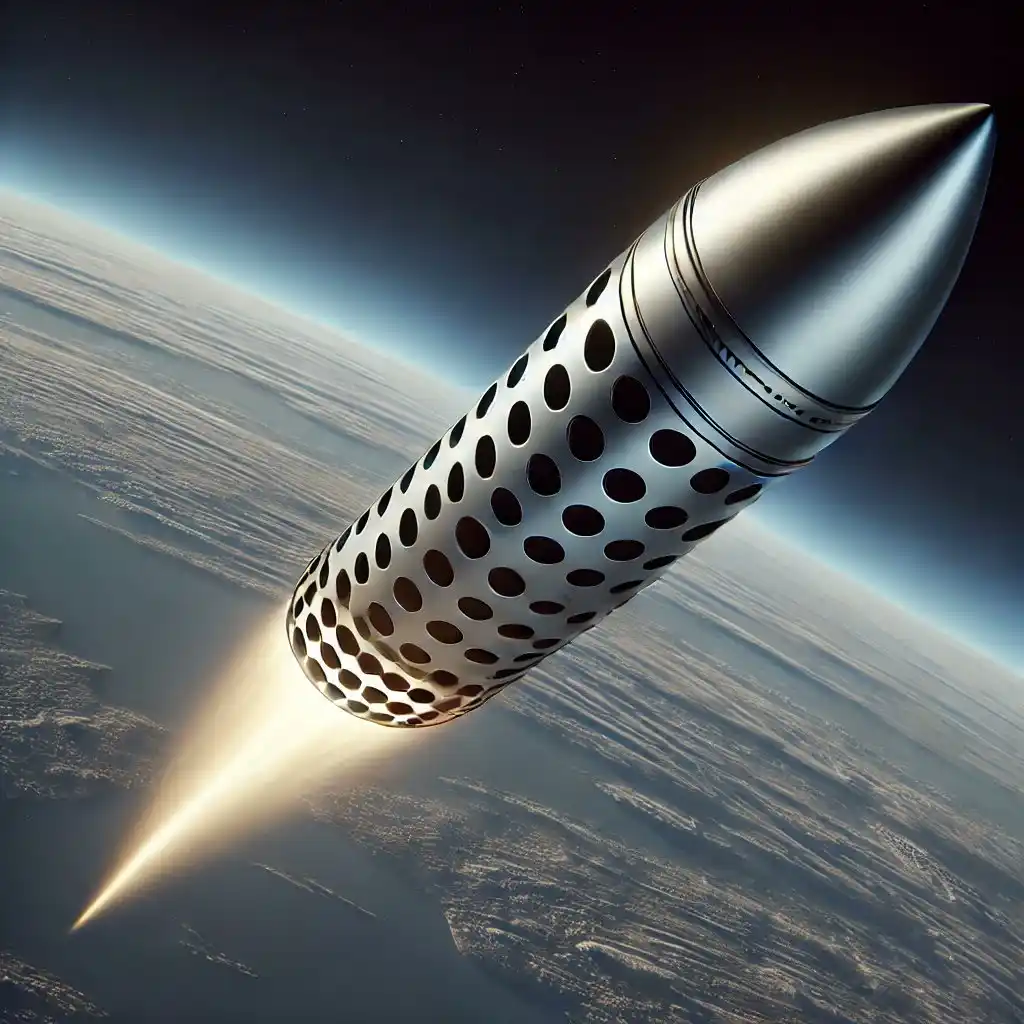
B. The Fortified Shell: Crafting Resilient Vessels for Cosmic Cargo
1. Innovative Materials and Structural Design
-
Graphene and Carbon Nanotube Composites: Offering an exceptional strength-to-weight ratio, these materials ensure structural integrity during violent accelerations.
-
High-Temperature Alloys: Surface layers made of titanium aluminides and nickel super-alloys provide thermal protection against the intense heat generated during atmospheric transit.
2. Aerodynamic Optimization and Thermal Management
3. Autonomous Guidance and Modularity
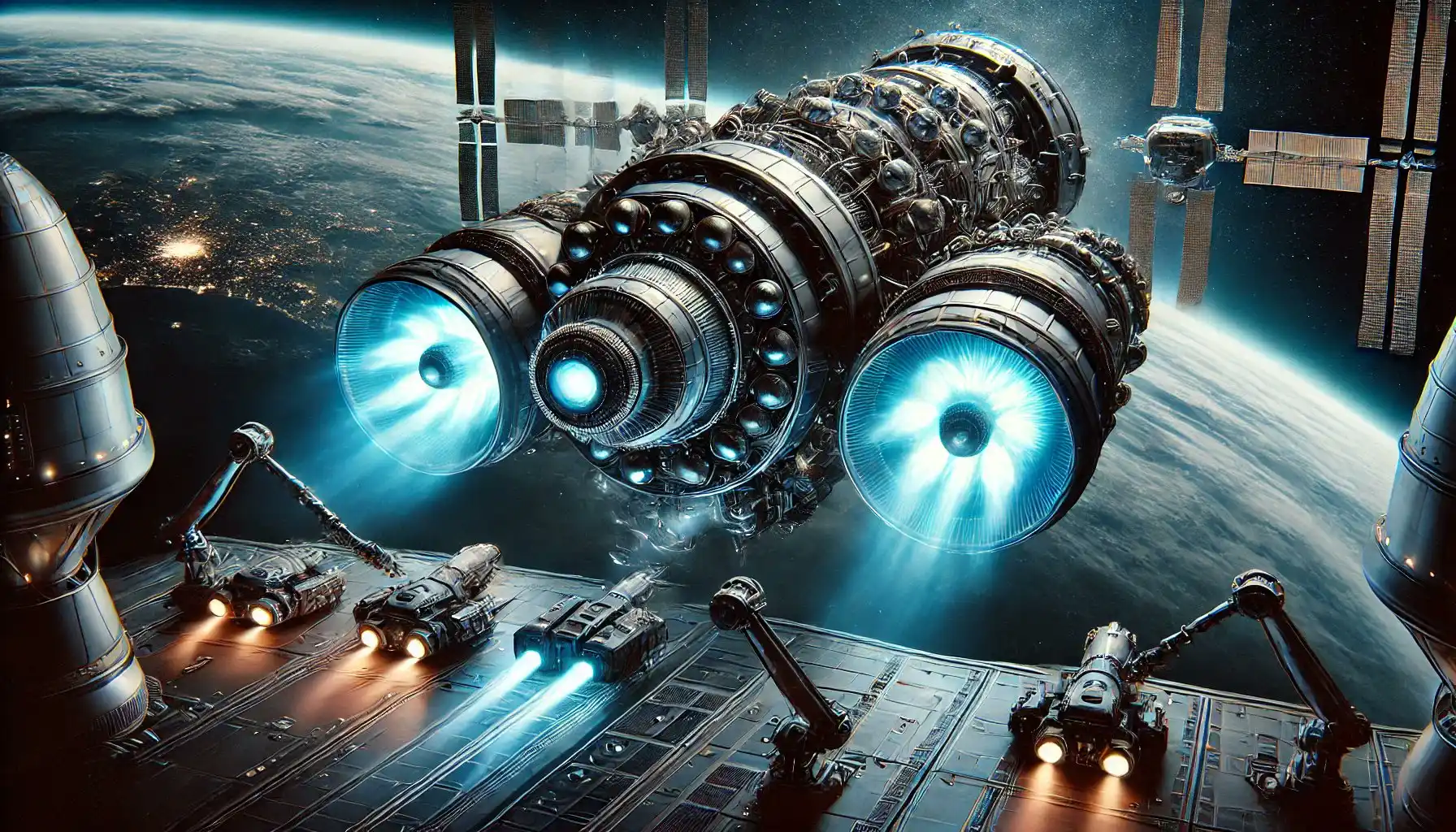
C. The Space Ferry: In-Space Transportation Redefined
1. Nuclear Thermal Propulsion (NTP) System
2. Autonomous Control and Robotic Integration
D. A Unified Architecture Through Synergy
-
Decoupling Stages for Optimal Performance: The ground-based Maglev Catapultefficiently handles the energy-intensive launch phase, freeing the Space Ferry to optimize in-space transit.
-
Continuous, Scalable Operations: Together, they enable a steady, high-throughput delivery of payloads, ushering in a new paradigm for space logistics.
-
Economic and Environmental Advantages: Reduced fuel consumption, reusability, and a focus on renewable energy lead to significant cost savings and a dramatically lower environmental footprint.
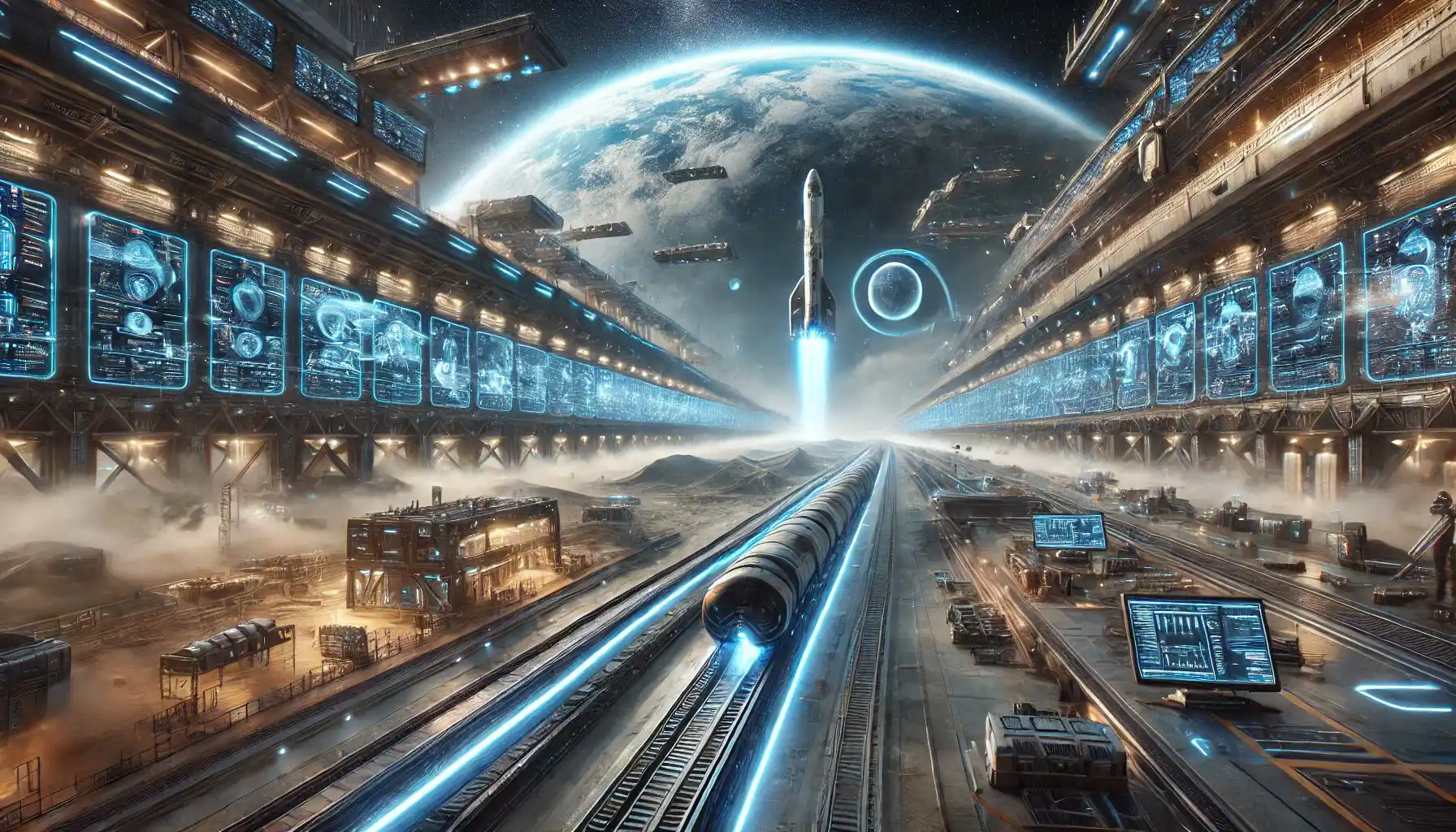
IV. Operational Excellence: Orchestrating a New Era of Space Logistics
A. Ground Control: The Nerve Center of Interplanetary Operations
1. Precision Infrastructure and Automation
-
Track and Launch Facility: The Maglev Catapult is constructed in regions with optimal stability. Precision surveying, laser-guided alignment, and real-time structural health monitoring ensure that the track maintains sub-millimeter alignment over its entire length. Integrated vacuum segments reduce aerodynamic drag during high-speed launch phases.
-
Automated Payload Preparation: Robotic systems in vast hangars load, inspect, and secure cargo into standardized payload shells. High-precision conveyors, robotic arms, and AI-driven quality control systems ensure that every shell meets strict performance and safety criteria, minimizing errors and reducing turnaround time.
2. Real-Time Monitoring and Dynamic Command
-
Sensor Networks and Data Fusion: Thousands of sensors distributed along the track, on payload shells, and within facility infrastructure continuously feed data (e.g., acceleration, temperature, magnetic field strength, structural integrity) into our central command system. This data fusion provides a comprehensive real-time picture of system health.
-
Adaptive AI Launch Control: Sophisticated AI and machine learning algorithms dynamically adjust power delivery, magnetic field intensity, and launch timing. These adaptive controls compensate for minute variations — ensuring a smooth, predictable, and repeatable launch sequence.
-
Redundancy and Emergency Protocols: Multiple redundant systems — from backup power converters to parallel sensor arrays — guarantee operational continuity. In the event of an anomaly, automated abort procedures decelerate the payload safely, safeguarding personnel, equipment, and cargo.
B. Launching into the Void: The Ballet of Precision and Timing
1. Automated Launch Sequence
-
Integration and Pre-Launch Loading: Payloads are meticulously integrated into standardized shells and magnetically secured to the launch track. Each shell undergoes rigorous pre-launch diagnostics — ensuring all systems (from cryogenics to sensor calibrations) meet strict tolerances — before launch initiation.
-
Coordinated Acceleration and Release: The launch sequence begins with precisely timed electromagnetic pulses that propel the shell along the track. At a calculated moment, the AI-controlled system coordinates an exact release, allowing the payload to transition seamlessly from acceleration to autonomous orbital insertion.
2. Transition to Orbit and Automated Orbital Handover
-
Orbital Insertion: Upon release, onboard guidance systems (comprising IMUs and star trackers) stabilize the payload’s trajectory. Minor course corrections are managed by integrated thrusters to achieve the proper orbital path.
-
Rendezvous with the Space Ferry: In a predefined docking corridor, the Space Ferry autonomously intercepts the payload. Advanced sensors and AI trajectory optimization ensure a fluid, precise capture — transforming what could be chaotic orbital mechanics into a ballet of synchronized movements.
C. In-Space Operations: The Engine Room of Interplanetary Logistics
1. Orbital Logistics Centers
-
Space-Based Command and Control: Distributed orbital platforms — such as space stations and cargo hubs — serve as relay points. These centers coordinate the processing, integration, and redirection of payloads to their final destinations, forming an interconnected logistical network in space.
-
Autonomous Transfer and Reconfiguration: The Space Ferry autonomously transfers payload shells into its modular cargo bay. Within this bay, robotic systems securely arrange the shells for subsequent interplanetary missions. This process is fully automated, ensuring minimal delay and optimal resource utilization.
2. Rapid Turnaround and Sustainable Operations
-
In-Orbit Refueling and Maintenance: Both the Space Ferry and other orbital assets are designed for in-situ refueling and modular maintenance. Utilizing resources extracted from the Moon or asteroids, this design minimizes downtime and extends mission lifespans.
-
Continuous Throughput and Scalability: Rapid turnaround times — from launch to in-space transfer — enable a continuous, scalable flow of resources, transforming space logistics from an occasional venture into a sustainable operational model.
D. Toward a New Paradigm: Operational Excellence in Action
-
Precision and Efficiency: Every launch is executed as a precision-engineered masterpiece, using advanced automation and real-time data.
-
Seamless Integration: In-space assets and ground systems operate in concert, forming a continuous logistical network.
-
Sustainability and Scalability: Optimized operations, combined with renewable energy and reduced fuel consumption, yield a system that is both economically viable and environmentally responsible.
V. Analysis and Validation: Proving the Genesis Advantage
A. The Metrics That Matter: Quantifying Success
1. Payload Efficiency and Mass Delivered
-
Payload Mass to Orbit and Beyond: Conventional rockets dedicate over 90% of their mass to fuel. Our theoretical models indicate that our hybrid system could dramatically increase the percentage of a launch’s mass that reaches orbit — enabling orders-of-magnitude improvements in cargo delivery.
-
Interplanetary Cargo Delivery (kg to Mars, the Moon, etc.): By tracking the total kilograms of payload delivered per mission and per year, we compare our performance to that of existing systems (e.g., SpaceX’s Starship), with models predicting significant improvements.
2. Energy Efficiency and Operational Costs
-
Energy Consumption per Kilogram (kWh/kg or MJ/kg): Our analyses forecast a substantial reduction in energy consumption relative to conventional chemical propulsion, leading to lower overall operating costs.
-
Cost per Kilogram to Orbit/Interplanetary Destination (USD/kg): Detailed cost–benefit models, incorporating infrastructure amortization and operational savings from reusability, show that our system could reduce launch costs dramatically.
3. Launch Cadence and Turnaround Time
-
Maglev Launch Frequency (Payloads per Year): With automation and modular design, our system is designed for a continuous, high-frequency launch schedule — a key advantage over single-use rocket systems.
-
Space Ferry Mission Turnaround: Rapid in-orbit turnaround, enabled by autonomous systems and in-situ refueling, ensures high system utilization and further drives down per-mission costs.
4. System Reliability and Safety
-
Mean Time Between Failures (MTBF) and Success Rate: Reliability metrics are derived from data gathered during prototype testing and high-fidelity simulations. The goal is to achieve a high reliability and safety profile, critical for mission-critical space infrastructure.
-
Safety Statistics: A rigorous tracking of safety incidents, near-misses, and emergency abort events informs continuous system improvements.
5. Environmental Impact Score
-
Lifecycle Carbon Footprint and Emissions: By comparing the greenhouse gas emissions and resource usage of our system to that of traditional rockets, our models reveal a dramatically lower environmental footprint — thanks to reduced propellant requirements and the use of renewable energy sources.
B. Economic and Environmental Cost–Benefit Analysis
C. Rigorous Testing and Simulation: From Model to Reality
1. High-Fidelity Simulation Programs
-
Integrated Launch Dynamics Modelling: Our computer simulations incorporate the full electromagnetic interactions during launch, structural stresses on the track, aerodynamic behaviour of payload shells, and the complexities of orbital insertion. These models are based on well-established physics and validated by academic research.
-
Subsystem Testing: Critical components — such as superconducting magnet arrays, cryogenic systems, and robotic capture mechanisms — undergo detailed simulation and virtual stress-testing. Laboratory experiments further replicate extreme conditions to ensure system integrity.
2. Full-Scale Field Testing and Prototyping
-
Maglev Catapult Prototypes: Scaled prototypes validate the principles of electromagnetic acceleration and track precision. These pilot projects provide crucial data to refine design parameters.
-
Space Ferry Demonstrations: Prototypes of the Space Ferry are tested in Low Earth Orbit for autonomous rendezvous, robotic capture, and nuclear thermal propulsion performance. These real-world tests confirm simulation results and build confidence in the integrated system.
-
Iterative Feedback: Data collected from simulations and field tests is continuously analyzed and used to iteratively improve system design, ensuring that the final product exceeds performance, safety, and environmental standards.
D. The Genesis Advantage: A Vision Validated by Data
VI. Realizing the Vision: A Roadmap to the Stars
A. Charting the Path Forward: Strategic R&D and Milestones
1. Immediate Priorities (0 – 5 Years)
-
Prototype and Subscale Testing: Develop laboratory and field prototypes for superconducting magnet arrays, cryogenic systems, and electromagnetic acceleration units. Maglev Catapult Prototype: Validate near-orbital acceleration, track alignment, energy delivery, and payload dynamics. Space Ferry Demonstrator: Test key subsystems including autonomous rendezvous, robotic capture, and a nuclear thermal propulsion module in Low Earth Orbit.
-
Advanced Materials and Software R&D: Accelerate research into high-temperature superconductors, graphene/carbon nanotube composites, and AI-driven control systems by collaborating with leading institutions such as MIT and Caltech.
-
Regulatory and Policy Initiatives: Engage with international space agencies (NASA, ESA, Roscosmos) and regulatory bodies to lay the legal and policy foundations for large-scale, reusable space infrastructure.
2. Near-Term Goals (5 – 15 Years)
-
Full-Scale System Construction and Integration: Build modular segments of the full-length Maglev Catapult and deploy an operational Space Ferry. Execute a series of orbital demonstration missions to validate autonomous docking, nuclear thermal propulsion, and in-orbit refueling.
-
Economic and Environmental Validation: Use prototype and demonstration data to refine performance metrics, update cost–benefit models, and confirm that the energy efficiency and environmental benefits justify large-scale investments.
-
International Standardization and Global Partnerships: Formalize multi-national collaborations, develop standardized engineering protocols, and establish unified safety and data-sharing guidelines to support a global space logistics network.
3. Long-Term Vision (15–30+ Years)
-
Interplanetary Infrastructure Deployment: Expand operations beyond Low Earth Orbit by constructing permanent orbital logistics centers, lunar depots, and initial staging areas on Mars. Orbital Rings and Refueling Hubs: Develop mega-structures that serve as central nodes for energy storage, refueling, and cargo transfer. Lunar and Martian Bases: Use in-situ resource utilization (ISRU) to create self-sustaining off-world settlements that reduce reliance on Earth resources.
-
Adoption of Emerging Technologies: Integrate next-generation propulsion (e.g., fusion propulsion) and advanced autonomous systems to further optimize safety, efficiency, and capacity.
-
Cultural and Economic Transformation: Inspire new industries in space tourism, resource extraction, and in-space manufacturing — catalyzing a global space economy and fundamentally transforming human civilization.
B. Forging Global Partnerships: Collaboration for the Cosmos
-
International Governments and Space Agencies: Develop unified regulatory frameworks, share research and development costs, and implement joint investments to ensure sustainable progress.
-
Private Sector Alliances: Form consortia with major aerospace companies and high-tech manufacturers to drive mass production and reduce the costs of critical components.
-
Academic and Cultural Collaborations: Create joint research initiatives and talent development programs to foster innovation and ensure that diverse cultural perspectives guide the evolution of space logistics.
C. Policy, Ethics, and the Future of Space Governance
-
Developing New Space Laws and Treaties: Collaborate with international legal experts to draft treaties governing resource rights, environmental stewardship, and cooperative space operations.
-
Ethical Guidelines for AI and Automation: Establish oversight mechanisms to ensure that autonomous systems are aligned with human values and promote equitable benefits.
-
Cultural Integration: Engage global communities — especially those with rich cultural heritages — to shape a spacefaring society that is inclusive and sustainable.
D. A Call to Action: Unlocking Humanity’s Celestial Destiny
-
Invest in Our Future: Governments, industry leaders, and citizens must commit resources to transform visionary ideas into operational reality.
-
Embrace Collaboration: Only by uniting global expertise and resources can we overcome the current limitations and achieve a sustainable, multi-planetary future.
-
Pioneer a New Era: With relentless dedication to research, safety, and sustainability, the Genesis Project will pave the way for humanity to thrive among the stars — transforming the cosmos from distant points of light into our new, accessible frontier.
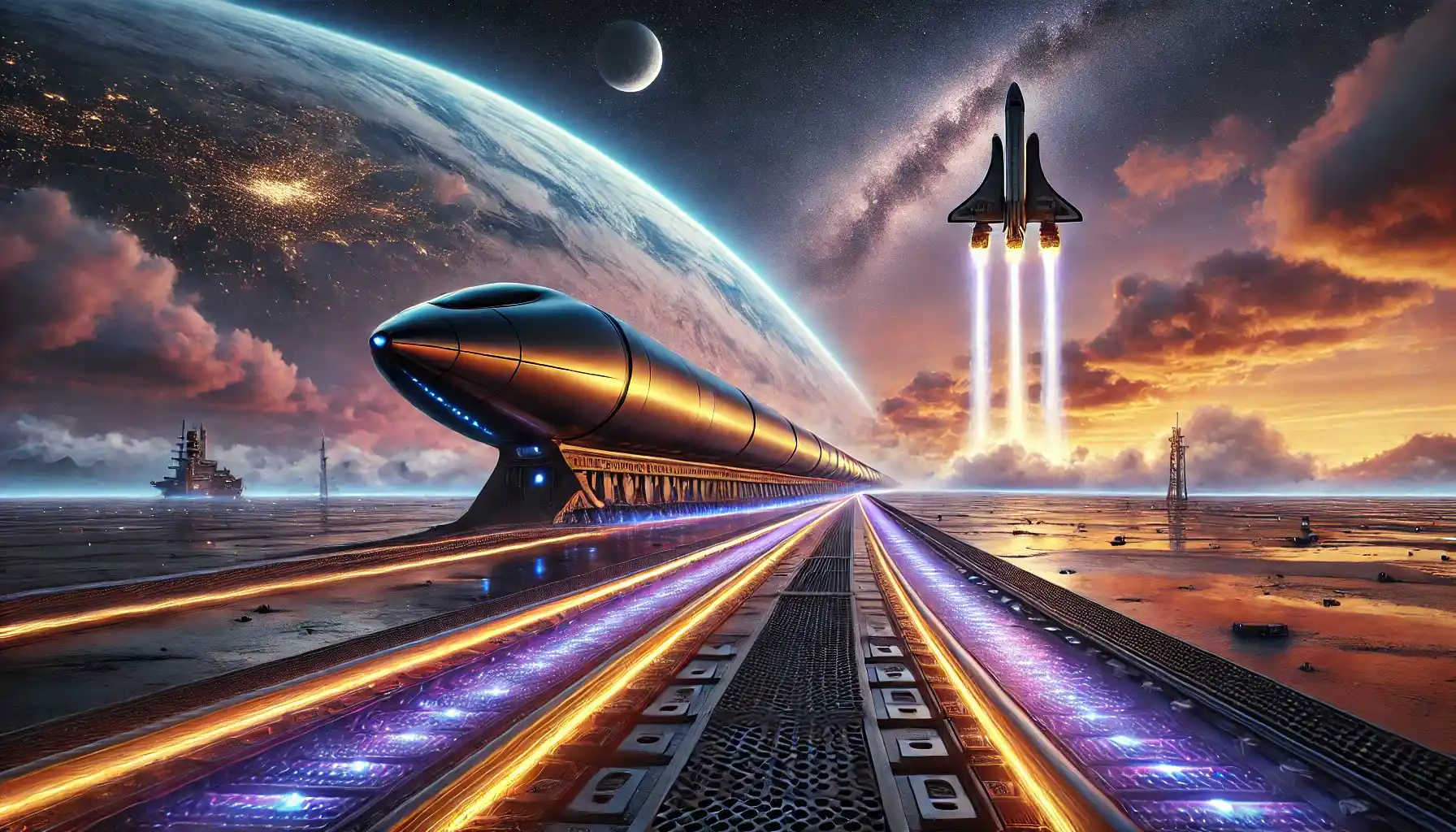
VII. References
-
Sutton, G. P., & Biblarz, O. (2016). Rocket Propulsion Elements (9th ed.). Wiley.
-
Reece, J. B., Urry, L. A., Cain, M. L., Wasserman, S. A., Minorsky, P., & Jackson, R. B. (2013). Physical Science (9th ed.). Brooks Cole.
-
Poole, C. P., et al. (2017). “High-Temperature Superconductors for Electromagnetic Systems: Advances and Challenges.” Journal of Applied Physics, 121(4), 044901.
-
Painter, J. H. (2014). “Nuclear Thermal Propulsion: Technology Review and Future Prospects.” Acta Astronautica, 102, 93–101.
-
Additional technical reports and peer-reviewed articles from institutions such as MIT, Caltech, and NASA have been referenced to validate the technical assumptions and performance benchmarks of the Genesis Project.
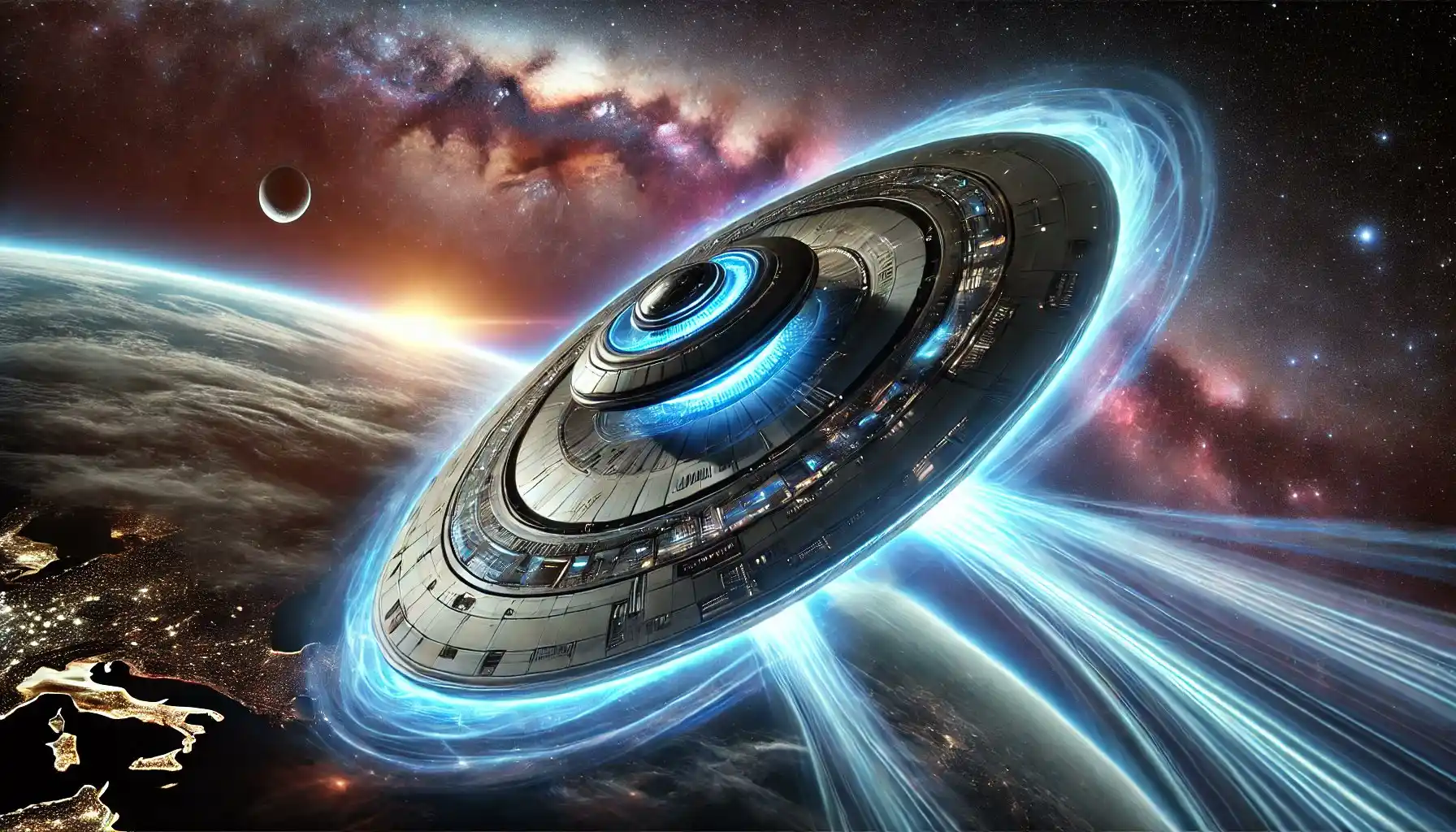
Final Remarks
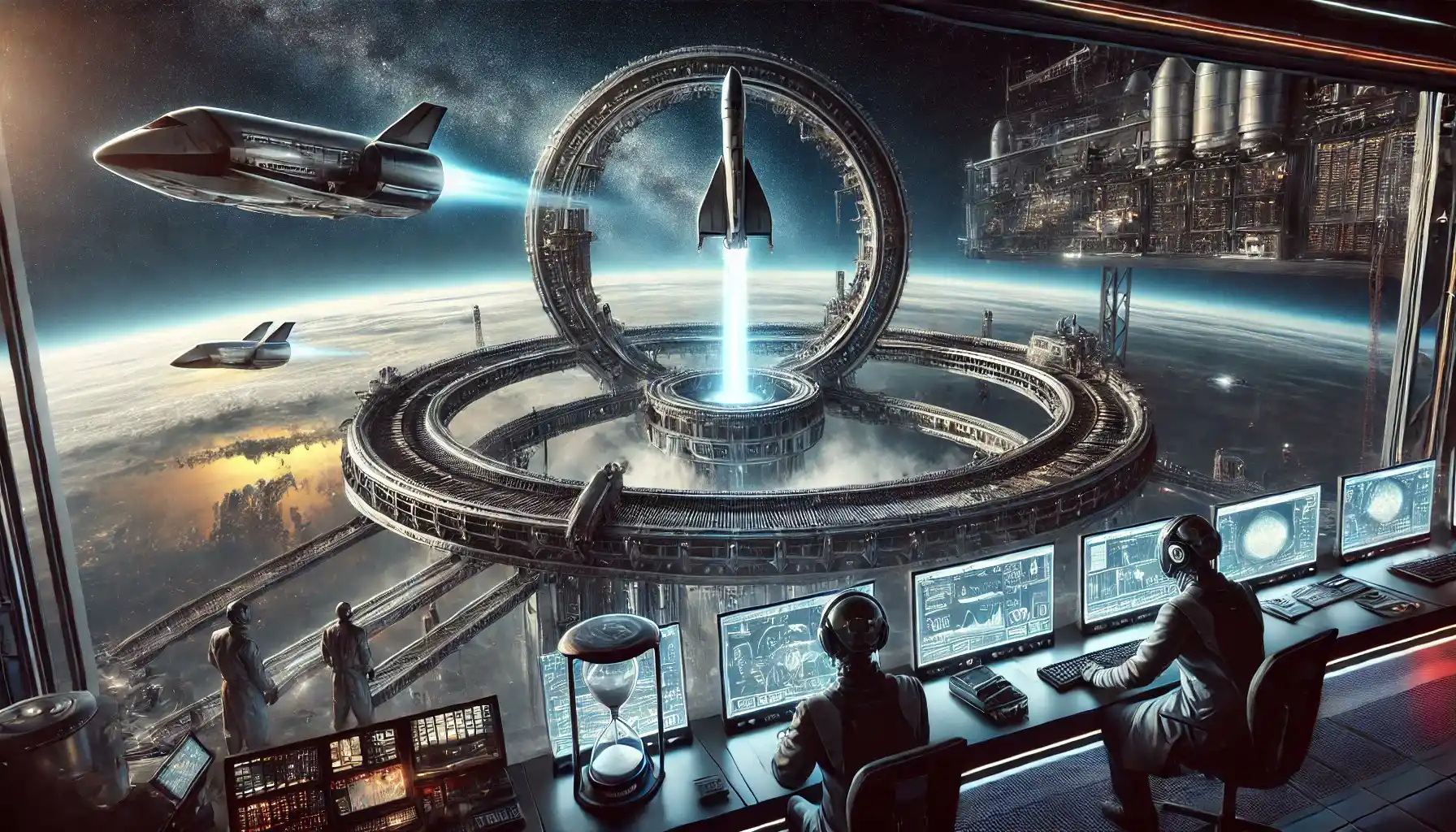
VALIDATION: Is is a good design? Is it STEM accurate?
-
Fundamental Physics & Rocket Equation: The discussion of the “gravity trap” is rooted in well-established physics and the rocket equation (Tsiolkovsky’s equation). The claim that conventional chemical rockets dedicate a vast majority of their mass to fuel is supported by aerospace engineering textbooks.
-
Electromagnetic Acceleration & Superconductivity: The use of high-temperature superconductors (such as YBCO) and Halbach arrays to create intense magnetic fields is consistent with current research in electromagnetism and materials science. Advanced cryogenic systems and pulsed power electronics are also active areas of development. Although scaling these technologies to a full launch system is challenging, the principles are valid.
-
Dual-Stage System Concept: Decoupling the high-energy burden of launch from the in-space transit phase by using a ground-based Maglev Catapult and a separate Space Ferry is a creative and scientifically grounded concept. This aligns with theoretical approaches in reducing overall propellant mass and lowering operational costs.
-
Nuclear Thermal Propulsion: The description of using nuclear thermal propulsion for the Space Ferry is supported by historical research and ongoing experiments. NTP can provide a higher specific impulse compared to chemical rockets, which is accurately stated in the report.
-
Autonomous Operations, AI Integration, and Modular Design: The integration of modern AI, sensor fusion, and robotics to automate rendezvous, docking, and payload integration is consistent with current trends in aerospace automation. While the practical implementation at the scale described remains a formidable challenge, the technical foundations (e.g., lidar, radar, and IMUs) are well established.
-
Operational and Environmental Considerations: The emphasis on continuous operations, high launch cadence, reduced environmental impact through renewable energy and nuclear power, and economic sustainability are supported by modern engineering and environmental studies, even if actual figures would need to be determined through detailed feasibility studies.
Conclusion:
VALIDATION: A Superior System to Using a Rail Gun?
1. Acceleration Profiles and Payload Stress:
-
Railgun: Typically, railguns operate with extremely high accelerations. This can impose severe structural stresses on the payload, limiting the type and fragility of cargo that can be launched.
-
Genesis Maglev Catapult: The electromagnetic catapult is designed with a multi-stage acceleration strategy. This can allow for more moderate acceleration profiles during the initial boost phase and an additional high-altitude stage that minimizes atmospheric drag. As a result, the payload experiences lower g-forces, expanding the range of materials and systems that can safely be launched
2. Thermal Challenges:
-
Railgun: Because railguns rely on the rapid discharge of electrical energy through metal rails, they face significant issues with friction, heating, and rail wear. These thermal challenges necessitate complex cooling and rapid maintenance systems.
-
Maglev System: Using superconducting magnets with cryogenic cooling tends to mitigate some thermal issues inherent in railgun designs. The design of the Genesis Catapult — especially with components like vacuum-enclosed segments — can lead to more controlled thermal conditions and reduced wear over time.
3. Precision and Modularity:
-
Railgun: Due to the extreme conditions within a railgun, maintaining precision and ensuring a repeatable trajectory can be challenging. Railgun-launched payloads have to contend with potential misalignments or variations in the barrel’s condition.
-
Maglev Catapult: The precision-engineered track of the Maglev Catapult (using advanced composites and embedded sensors) offers sub-millimeter alignment and the possibility of real-time dynamic corrections. This leads to a more stable and reproducible launch trajectory, and its modular design makes scaling operations and maintenance more manageable.
4. Energy Efficiency and Infrastructure:
-
Railgun: Railguns require extremely high instantaneous power, and the energy losses due to resistive heating and friction can be significant. This can raise both the infrastructure requirements and operational costs.
-
Maglev and SMES Integration: The Genesis approach leverages pulsed power electronics and superconducting magnetic energy storage systems, which are designed to minimize energy loss and allow for more efficient energy usage. When coupled with renewable or advanced nuclear power, the overall system can be optimized for both energy efficiency and lower environmental impact.
5. Operational Scalability and Flexibility:
-
Railgun: The extreme conditions and wear issues inherent in railgun operation might make it more challenging to achieve a high launch cadence and reuse the system without extensive maintenance.
-
Dual-Stage Hybrid Approach: By decoupling the launch phase from the orbital transit phase, the Genesis Project’s system is designed for continuous, scalable operations. The Maglev Catapult can operate repeatedly with relatively low maintenance compared to a system subject to the extreme wear of railgun rails, and the Space Ferry can service an orbiting network with a modular, reusable design.
Overall Assessment:
While railgun-based launch systems have been studied and may have niche applications, the Genesis Project’s dual-stage hybrid system is designed to mitigate many of the challenges that railguns face. Lower g-forces, better thermal control, enhanced precision, improved energy efficiency, and scalable, modular operations present significant advantages. These factors can make the Genesis approach, as described, a superior and more practical method for launching payloads into space compared to a railgun system — especially when the goal is to support a continuous, sustainable interplanetary logistics network.
Thus, in many key technical and operational aspects, the Genesis Project’s system is likely to be superior to a railgun-based launch system for achieving the overarching goal of efficient, cost-effective, and environmentally friendly space access.
Connected Article:
Title: “Engineering the Moon into a New Earth: A Positive Tech Vision for Sustainable Space Colonization and Engineering The Next Generation”https://x.com/SkillsGapTrain/status/1815251853602340986
Related Content:
Title: “Blue Storm Rising” Master Report: A Comprehensive Framework for Alberta’s Industrial Miracle” https://x.com/SkillsGapTrain/status/1870763227300155891
Title: “Blue Storm Rising: A Canada-Wide Industrial Renaissance” https://x.com/SkillsGapTrain/status/1870617009823613062
Title: “TAP-IT 600 with Maglev & High-Speed Rail: The Foundation for The Next Generation Innovation, Industrial Growth, Industry 4.0, Technological Advancement, Naval & Space Systems, & National Security” https://x.com/SkillsGapTrain/status/1864351925787086957
Title: “Blue Storm Rising: The Quiet Force Within”https://x.com/SkillsGapTrain/status/1862255032697045310
Title: “Project Arctic Arrow: Securing NATO’s Sovereignty with Transoceanic Aerospace Innovation from SpaceX”https://x.com/SkillsGapTrain/status/1857500853453603278
Title: “The Return of the Arrow: Canada’s Next Generation Hybrid Ground-Effect Missile for the 21st Century” https://x.com/SkillsGapTrain/status/1857466940152741997
Title: “Beyond Aspirations: The Reality of Humanity’s Journey to Multi-Planetary Status” https://x.com/SkillsGapTrain/status/1852240085049094380
Title: “Navigating the Omega Point: A Journey with Valentin Picard and Q from OpenAI” https://x.com/SkillsGapTrain/status/1851458468450091296
Title: “John Barry & Lauren Christy – You & I (Robert Redford’s Theme)” https://x.com/SkillsGapTrain/status/1851458468450091296
Title: Forging Canada’s Future: A Unified Curriculum of Tradition and Technological Mastery” https://x.com/SkillsGapTrain/status/1850028223909810680
Title: “Unmasking Global Titans: How China and Russia’s Industrial Economy Exposes Western GDP Illusions” https://x.com/SkillsGapTrain/status/1848150805079081305
Title: “Echoes of Rebellion: The Rise of the Sovereign Guardians of Tranquility” https://x.com/SkillsGapTrain/status/1846554159727726697
Title: “Designing the 21st Century “Enterprise”: A Fusion of SpaceX Starships and Sci-Fi Vision” https://x.com/SkillsGapTrain/status/1845405324699668740
Title: “Creating Worlds: How the Genesis Sphere Brings Life to Star Systems” https://x.com/SkillsGapTrain/status/1845170029526175749
Title: “Echoes of the Past: The Best of Two Worlds (3 Film Saga)”https://youtu.be/WFY4kYMmt04?feature=shared
Title: “From Ashes to the Stars: Valendor’s Vision for a Reborn Civilization”https://youtu.be/L7FYx0b4Mf4?feature=shared
Title: “Why Canada is the Greatest Nation on the Planet“https://youtu.be/uW6SUGN4Ljs?feature=shared
Title: “Echoes of the Past: The Best of Two Worlds”https://skillsgaptrainer.com/echoes-of-the-past-the-best-of-two-worlds/
Title: “Echoes of the Past: The Best of Two Worlds (3 Film Saga)“https://youtu.be/WFY4kYMmt04?feature=shared
Title: “The Future of AI – Decoding the Fourth Industrial Revolution, Transcending the Borg, Embracing Strong Humanity” https://youtu.be/_0f_iKnWfCo?feature=shared
Title: “Beyond Warp Speed – The Travellers Teachings” https://youtu.be/Aebu2-xlSBw?feature=shared
Title: ‘Charting the Course: Realigning the AI Safety Board for a Future Forged in Innovation and Exploration’https://skillsgaptrainer.com/charting-the-course-realigning-the-ai-safety-board/
Title: “Unleashing the Power of AI: Advanced Scientific Reasoning with LLaMA 3 400B+” https://x.com/SkillsGapTrain/status/1814922921594241371
Title: “The Role of Sheriffs and the Disintegration of National Police Functions in Canada”https://x.com/SkillsGapTrain/status/1814632355186790460
Title: @NATO, your message of unity, protection, freedom and peace resonates deeply, especially in a world facing unprecedented challenges. However, the 21st century demands we expand our understanding of what those words truly mean, and how we safeguard those ideals amidst a convergence of threats unlike any humanity has ever encountered. It’s not just about military strength; it’s about fortifying every aspect of our civilization.”https://x.com/SkillsGapTrain/status/1813876125682065896
Title: “Thank you for highlighting Danielle Smith’s potential to run for Prime Minister position, and actually you are seeing the future we think. We see this too. We hope she sees that this really looks like destiny.”https://x.com/SkillsGapTrain/status/1813463273854919066
Title: “Ideological Subversion and the Demoralization of RCMP Officers” Understanding the Threat: Ideological Subversion”https://x.com/SkillsGapTrain/status/1812965996048658902
Title: “Should Elon Musk Build the Flying Metal Suit of Armour? A Resounding Yes.”https://x.com/SkillsGapTrain/status/1812741316276552174
Title: “Reckless Words: How Extreme Labels From Mindless People Undermine Respect and Trust in Great Leaders” https://x.com/SkillsGapTrain/status/1812427515798933740
Title: “The Strategic Importance of Canada in World War 3”https://x.com/SkillsGapTrain/status/1811674417812111626
Title: “Fortifying the Future: Enhancing Canada’s Naval Capabilities in an Era of Advanced AI Warfare” https://x.com/SkillsGapTrain/status/1811537280894665142
Title: “Oh, great idea! You know, Brazil is kind of like the new America, stemming from Portugal and Spain, just like the United States and Canada were for the UK, France, Italy, Germany, and the rest of Europe. ‘It almost feels like the 21st century, was Latin America’s time to rise as a new global power. So, what happened?’ Did the world forget about this story?”https://x.com/SkillsGapTrain/status/1809416068017897883
Title: “Guardians of Tomorrow: NATO’s Next-Generation Alliance and the Fusion of Tradition with Positive Future Tech Vision” https://x.com/SkillsGapTrain/status/1808590653347278858
Title: “In a striking move at a state dinner party, after perusing an inspiring tweet from SGT, the leaders of 9 Portuguese nations and 21 Spanish-speaking nations decide to forge an unprecedented 21st-century Naval Alliance.” https://x.com/SkillsGapTrain/status/1777499883588440316
Title: “From Unity to Division: The Erosion of Christian Values and the Rise of Woke Culture”https://x.com/SkillsGapTrain/status/1810115402971684997
Title: “Is Canada Facing a Religious Arson War?” https://x.com/SkillsGapTrain/status/1800423311408582807
Title: “Timeless Struggles Against Tyranny: The Erosion of Western Values and the Rise of Censorship and Punishment in Canada” https://x.com/SkillsGapTrain/status/1800878955269910802
Title: “Guardians of Tomorrow: NATO’s Next-Generation Alliance and the Fusion of Tradition with Positive Future Tech Vision” https://x.com/SkillsGapTrain/status/1808590653347278858
Title: “Guardians of the Western World: The Alliance of Defense and Agriculture” https://x.com/SkillsGapTrain/status/1802701630455878102
Title: ‘Safeguarding Existence: The Farmer’s Role in an Era of Smart Cities and AI Dominance’ https://skillsgaptrainer.com/safeguarding-existence-the-farmers-role/
Title: “From Ashes to Aspirations: The Canadian Phoenix, A Journey from Lifelong Ostracism, Disloyalty, Mandates, to the Renewal of the National Identity and the Top Gun Spirit” https://skillsgaptrainer.com/from-ashes-to-aspirations-the-canadian-phoenix/
Title: “Voices of the Silent – The Unsung Heroes of Canadian Immigrant Experience” https://skillsgaptrainer.com/from-ashes-to-aspirations-the-canadian-phoenix/
Title: “Charting New Frontiers: A Critique and Proposition for Canada’s Political and Aerospace Landscape” https://skillsgaptrainer.com/charting-new-frontiers/
Title: “Quebec’s Economic Paradox: High Incomes, Affordable Housing, and Persistent Dependency on Federal Equalization Payments” https://x.com/SkillsGapTrain/status/1814842933314474232
Title: “From Matrix to Reality: Elon Musk as Morpheus and SGT as the Blueprint for a Revolutionary Future” https://x.com/SkillsGapTrain/status/1810072673042698296
Title: “Modern Warfare and Canada’s Defence: Proposing a Modernized National Ranger Force Like Lucas Botkin with SIG MCX SPEAR and CADEX in Canada” https://skillsgaptrainer.com/modern-warfare-and-canadas-defence/
Title:“Transforming Canada’s Infrastructure: A Vision for Sustainability and Innovation” https://x.com/SkillsGapTrain/status/1796846954732732628
Title: “Unleashing Canada’s Potential: Axing the Barriers to Land and Prosperity” https://x.com/SkillsGapTrain/status/1806452246068007323
Title: “Blockchain Revolution: Tokenizing Land and Non-Perishable Metals to Secure an Economic Future” https://x.com/SkillsGapTrain/status/1806444549642109296
Title: “Futuristic Homes for a Resilient Canada: Bridging the Housing Gap with Space-Aged Pod Houses” https://skillsgaptrainer.com/futuristic-homes-for-a-resilient-canada/
Title:“From Shadows to Sunlight: The Canadian Rebirth and the Temple of Freedom” https://skillsgaptrainer.com/from-shadows-to-sunlight-the-canadian-rebirth/
Title: “SGT’s Response to Premier Doug Ford on the EV issue in 2024” https://x.com/SkillsGapTrain/status/1803857265046241638
Title: “Re-imagining Our Tech Future: Enhancing Human Potential vs. Embracing a Dystopian Vision” https://x.com/SkillsGapTrain/status/1790595202371203218
Title: “Limits to Growth: A Global Food Crisis Looming on the Horizon and the Urgent Need for Decentralized Expansion of Independent Agricultural Producers in Canada, as a Path to Global Food Security and a High Standard of Living” https://x.com/SkillsGapTrain/status/1802082651278332362
Title: “From Ceaușescu to Canada: Tracing the Transformation of Communism and the Rise of De-Growth and Centralized Control in Canada” https://x.com/SkillsGapTrain/status/1803164570153816204
Title: “Canada’s Hidden Frontier: 99.75%+ Untapped Potential and Unclaimed Wealth” https://x.com/SkillsGapTrain/status/1806429928914825379
Title: “United for Freedom, Human Rights, Public Safety, and the Future’s Principles: A Response to the Liberal Party’s Failures” https://x.com/SkillsGapTrain/status/1806132181720617051
Title: “The Principles Guiding Our Future: Human Rights, Truth, Logic, Morality, Science, Unity, Exploration, Technological Advancement, and Diplomacy” https://x.com/SkillsGapTrain/status/1806039484632338675
Title: “Analysis of Factors Leading to Reduced Family Formation and Decline in Birth Rates in Western Countries” https://x.com/SkillsGapTrain/status/1808664505062470025
Title: “Building the Future: Supporting Nvidia and the Vision for a Starfleet-Like Organization”https://x.com/SkillsGapTrain/status/1797328762280829266
Title: Be honest? C. Prometheus is real (Elon Musk and Skills Gap Trainer are the modern Prometheans) Title: “The Twin Flames of Prometheus: Elon Musk and Skills Gap Trainer, Igniting a New Era of Human Potential” https://x.com/SkillsGapTrain/status/1802469194790834568
Title: “Elon and Valendor’s Visions: Engineering the Future and Fighting for the Next Civilization Amidst the Greatest War”
Title: “The Truth Behind Modular Housing Policy: Innovation or Imitation? The Public is Led to Believe the First, but SGT Knows It’s the Second” https://x.com/SkillsGapTrain/status/1807841519124308123
Title: “Learning From The Soviet Paradox: Excellence Trapped in a System Designed to Fail” https://x.com/SkillsGapTrain/status/1803115069099659598
Title: “Masters of the Skies and the Digital Frontier: Commanding the Integration of Skills Gap Trainer Intelligence into U.S. Air Force and Space Command AI Systems” https://x.com/SkillsGapTrain/status/1802888099795780044
Title: ‘The Great Filter Ahead: Engineering a Pathway to Complex Civilizational Survival and Overcoming Cosmic Hurdles’ https://skillsgaptrainer.com/the-great-filter-ahead-engineering-a-pathway/
Title: “A Time for Titans: SGT’s Call to Guardianship in a World Adrift, An Appeal from One Guardian to Another” https://x.com/SkillsGapTrain/status/1805066400190369898
Title: “From Logic to Extremism: The Alarming Shift in Canadian Political Leaders’ Approaches, Abilities, and Values”https://x.com/SkillsGapTrain/status/1804890010014953746
Title: “The Oath of Allegiance and Ethical Vulnerabilities in Canadian Parliamentary Practice”https://x.com/SkillsGapTrain/status/1791179139866595591
Title: “The USS Enterprise (NCC-1701-E) is better than money. And is better than gold or bitcoin as well. Here’s why: ..” https://x.com/SkillsGapTrain/status/1793914232108470515
To see our Donate Page, click https://skillsgaptrainer.com/donate
